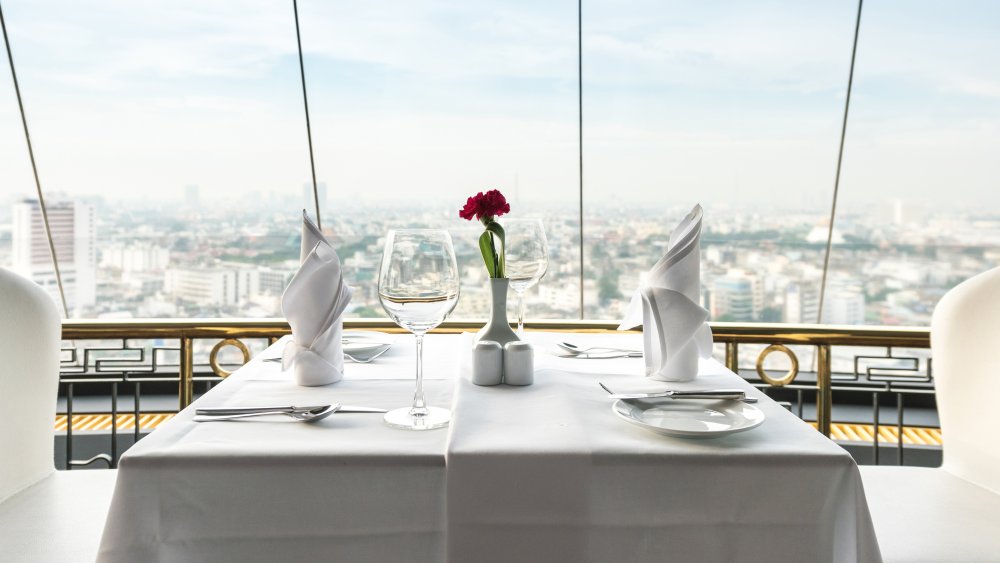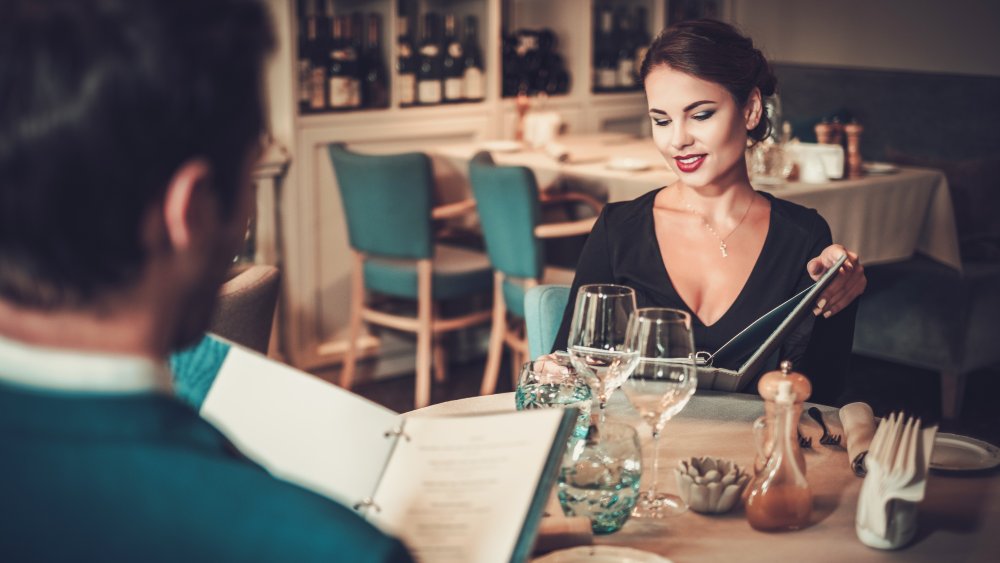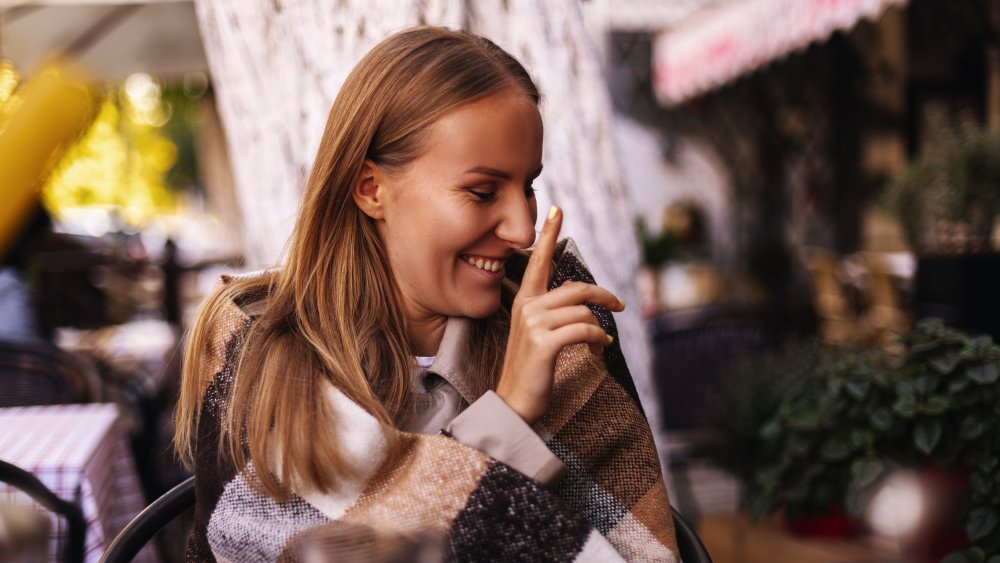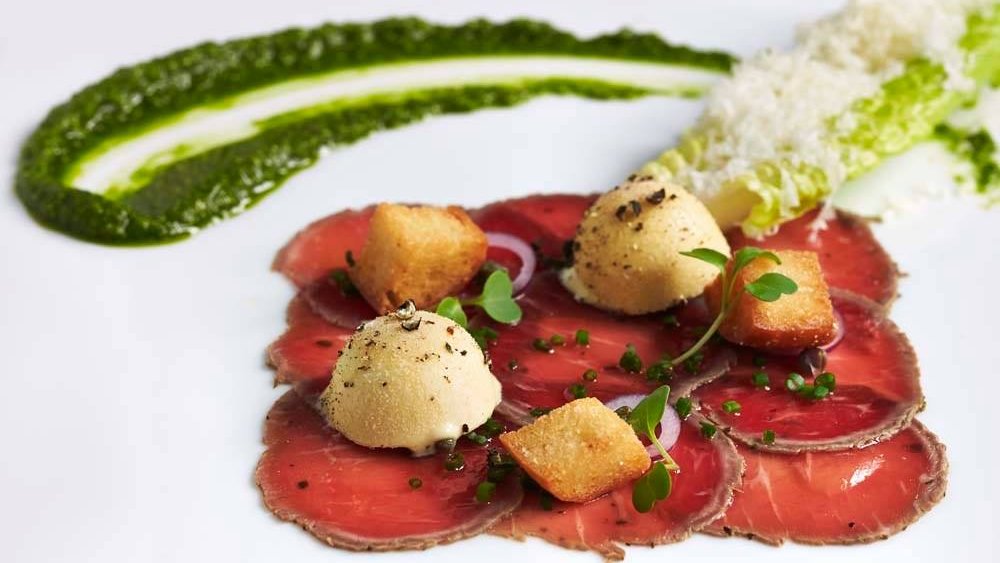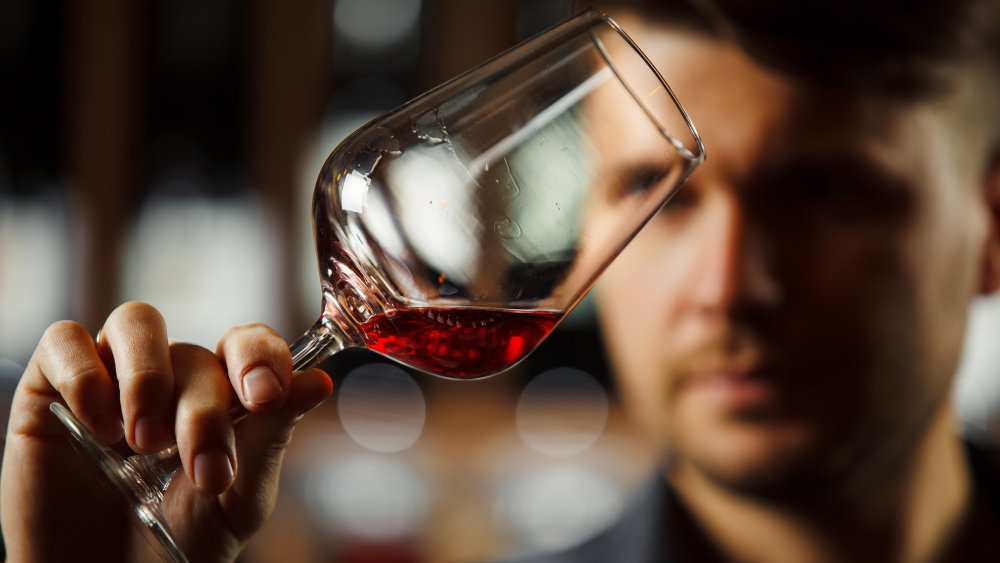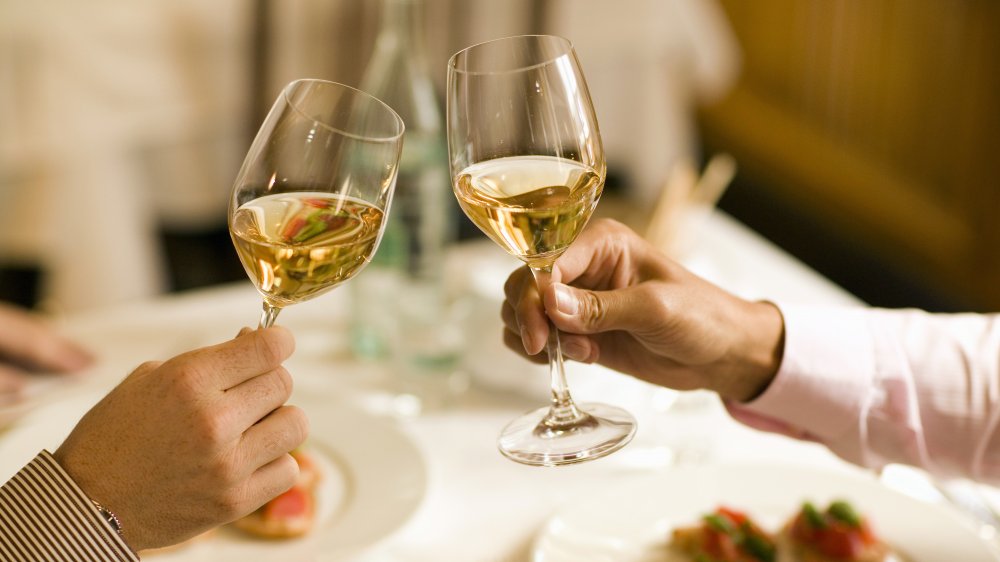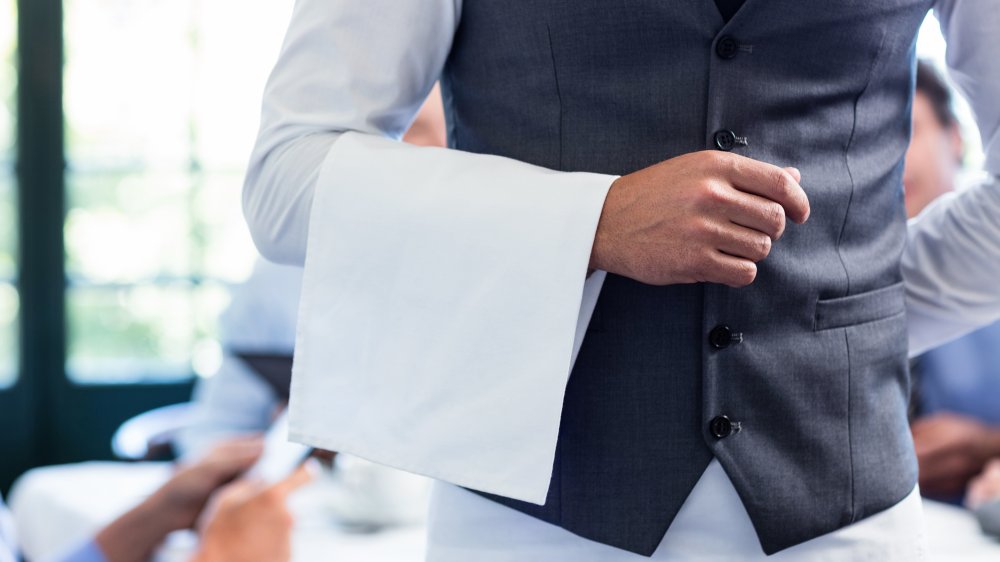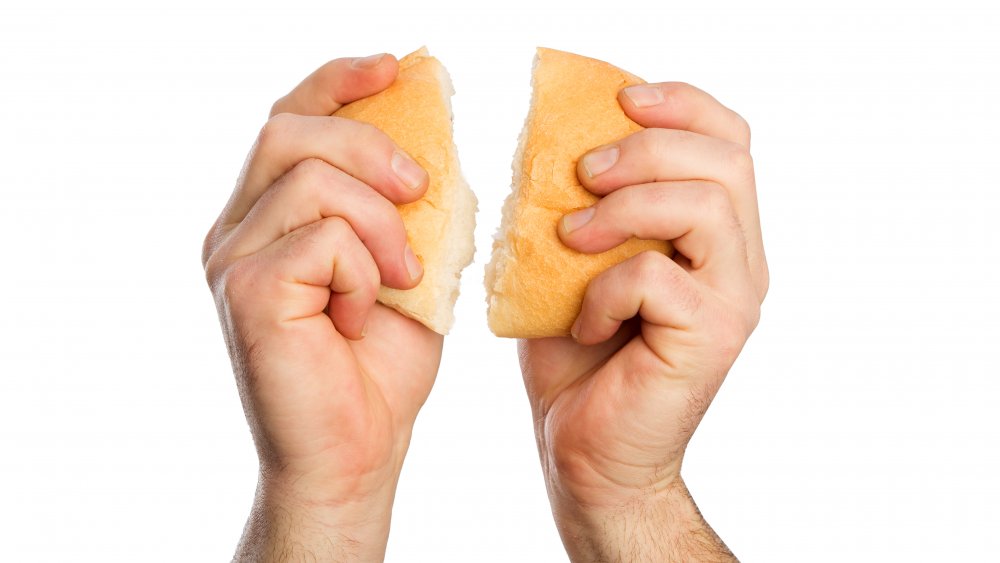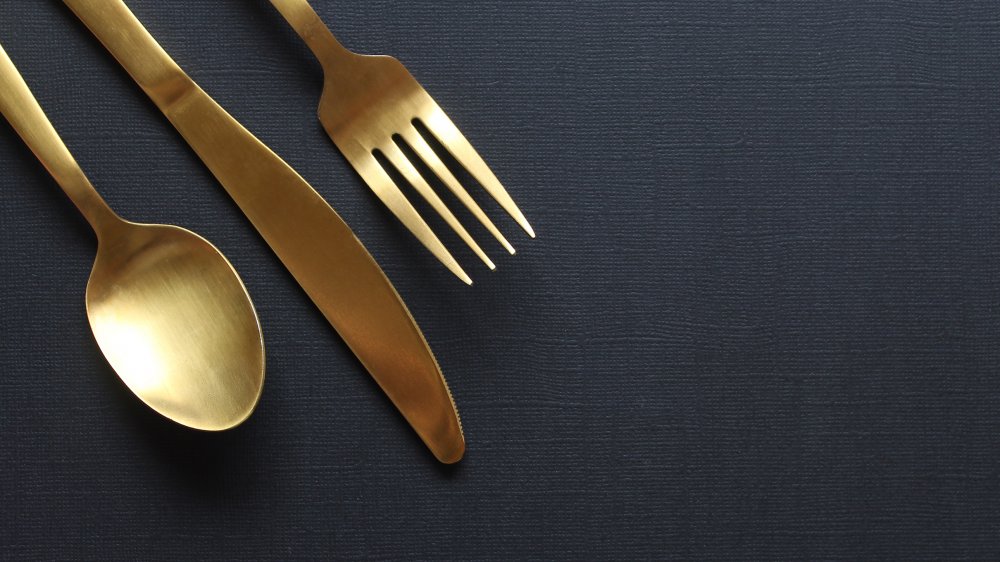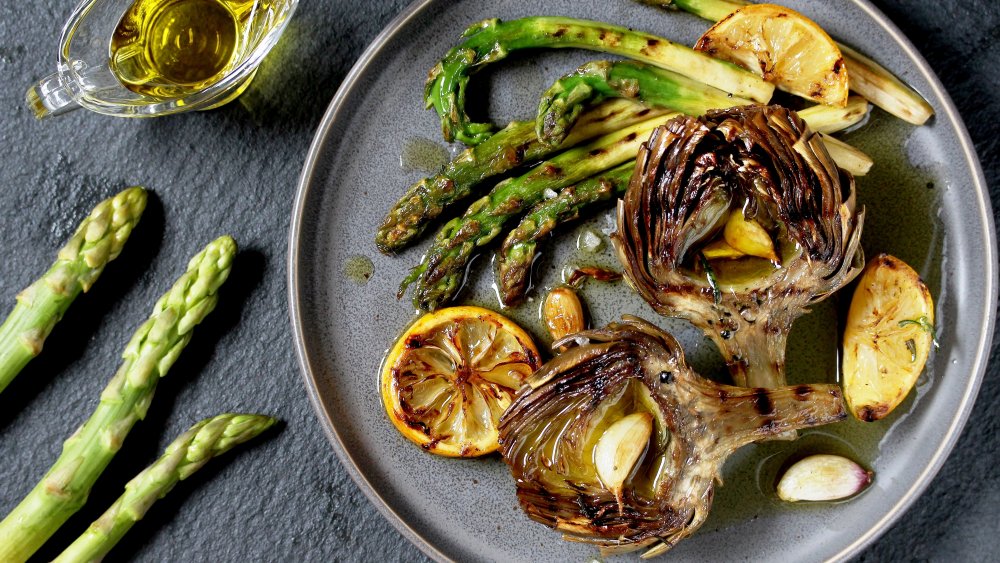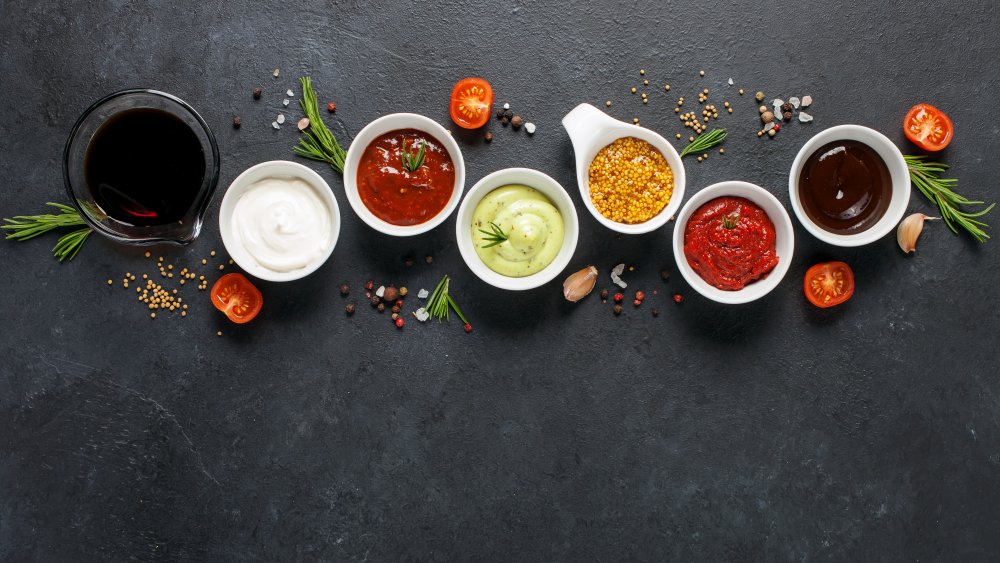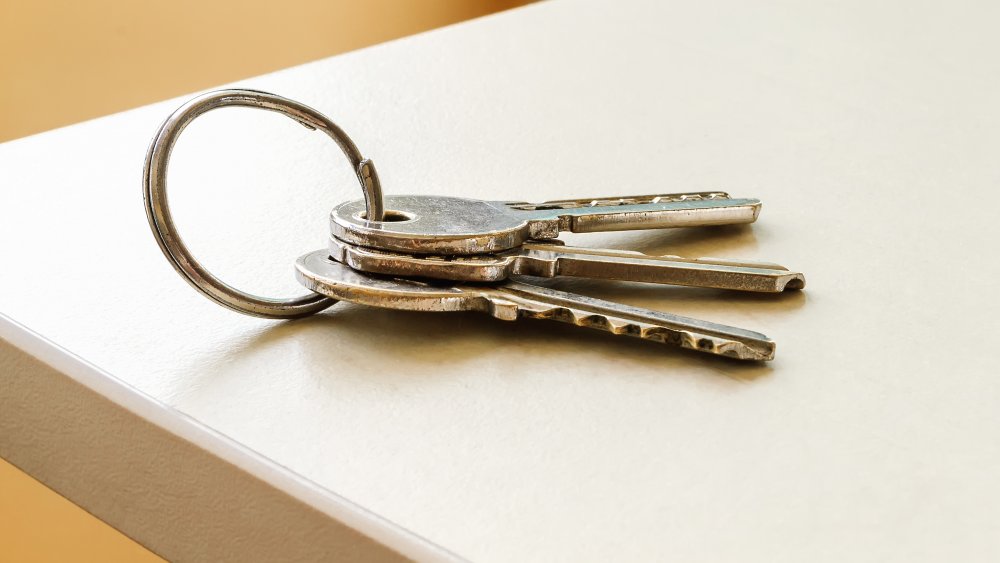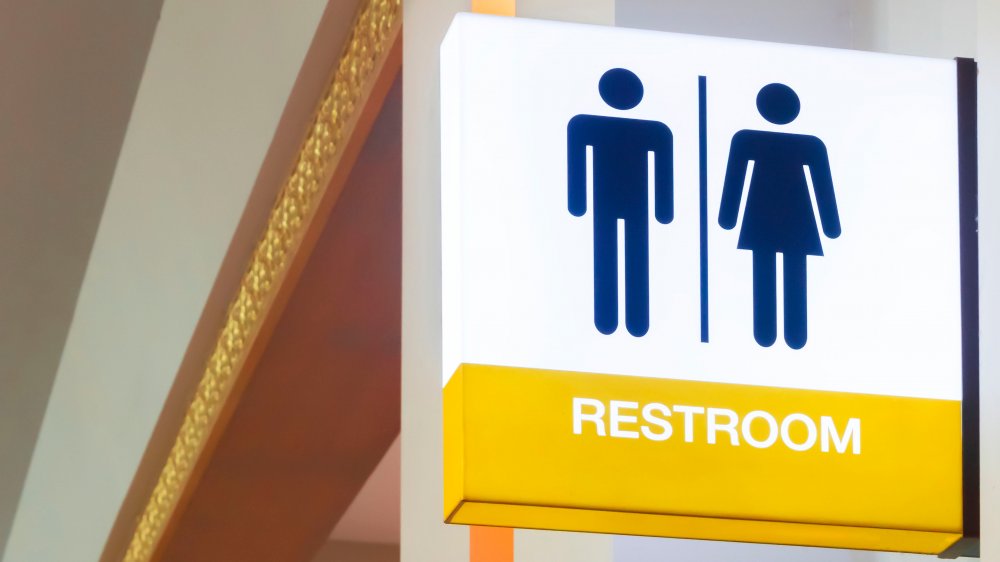Weird Rules That Fancy Restaurants Follow
In our increasingly casual, Instagram-mable and foodie-centric age, the notion of fine dining has morphed considerably. Even the starriest of Michelin restaurants have relaxed dress codes and the scandalous faux-pas of yesteryear — such as reaching across the table — are a moot point in the era of communal dining and small shared plates.
That said, fine dining etiquette is still alive and well in upscale eateries across the globe. Following seemingly obscure rules governing how to properly break and then butter your bread and what to do, or not to do, with leftover olive pits at a fancy restaurant may strike some as antiquated, absurd, or both. However, being conscious of these codes of conduct serves two worthy purposes. It allows dining companions who may adhere to such rigorous rules to feel more comfortable in your presence. It might just also spare you potential humiliation if, in your ignorance, you commit a transgression such as daring to rest a roll on your plate or commit a double-dip offense. With these considerations in mind, we've rounded up a list of some of the weirder rules you might encounter the next time you find yourself staring a perfectly folded swan-shaped napkin in the face.
There's no heavy lifting at fancy restaurants
When dining fine, potential faux pas begin the minute you're seated at your table (assuming you remember to let your waitperson pull your chair out for you). Of course, you're going to be eager to pore over the menu, but curb your enthusiasm by keeping it on the table.
Founder of the Plaza Hotel Finishing Program Myka Meier boned up on the intricacies of fancy restaurant etiquette with a former member of The Royal Household. In other words, she's schooled in how the Queen — her actual Majesty as opposed to the Emmy-winning Olivia Colman version — behaves when sitting down to dinner with (Prince) Philip. In a Food and Wine article, Meier reveals that "in formal dining, the menus should always be touching the table in one place." She generously acknowledges the irresistible temptation — particularly for those too vain to put their glasses on — to lift the menu up and bring it up to your face. However, she stresses that "the bottom, or at least one part of it" must maintain contact with the table at all times.
Don't call for your waiter at a fancy restaurant
Having mastered the proper way to wield your menu, you're hopefully inspired enough to order something from your server. Some diners are intimidated by waitstaff. Others are given to imperiousness. Regardless of where you fall on the confidence spectrum, there's a right way and a wrong way to communicate with your server.
When BestLife compiled a list of "small — but egregious — mistakes" committed at fancy restaurants, it turned to Patricia Napier-Fitzpatrick, an expert at the Etiquette School of New York, who identified raising your voice to get the waiter's attention as one of the most egregious of all. Says Napier-Fitzpatrick, "Unless someone is choking on his or her food and you're too scared to administer the Heimlich yourself, you should never, ever yell across the room at a waiter when you need something."
In a less catastrophic context, Napier-Fitzpatrick recommends communicating via subtle eye contact. If your best attempts at come-hither glances are missing the mark, she concedes that it's time to bring out the big guns, or rather gun, by "put[ting] up your index finger of your right hand, ever so slightly."
Powerful eye contact and index finger dexterity are particularly important if you're the hostess or host. According to Napier-Fitzpatrick, "the person hosting the meal is the one responsible for getting the attention of the waiter so that they can order." Thankfully, that means that everyone else at the table can relax their gazes and their hands.
Fancy restaurants expect parallel orders and eating
Once you, or your eye-roving, finger-wiggling hostess/host, has succeeded in bringing your waitperson into your orbit, you're ready to order at your fancy restaurant. Before taking the plunge, you need to make sure you're on the same page as your dining companions regarding how few or many courses you plan to devour. The Internet is rife with specialists warning diners to eschew individualism and order the same number of courses as their fellow diners. According to a BuzzFeed article, the rationale behind such altruism is to "avoid the awkwardness of anyone sitting with idle hands, watching you eat."
Even once you've matched yourself, course-by-course, with your companions, it doesn't mean you can relax and give into the hungry urges of your id. Fine dining is like running a marathon — you need to pace yourself. A Business Insider article recommends taking your time and pausing after every few bites so that nobody will feel rushed.
Eating etiquette guru Patricia Napier-Fitzpatrick calls out men in particular for sprint-eating. "Some men just gobble their food down," she exclaimed to BestLife. However, realizing there's no use crying over spilled milk — or a scarfed-down order of escargots — Napier-Fitzpatrick advises doing damage control in the event of poorly paced pigging out. If you find yourself emptying your plate before your companions, and you still have a few crumbs of food left, place your silverware in the resting position. This strategy allows you to maintain the facade that you're still eating.
No swirling allowed at fancy restaurants
In a fancy restaurant, ordering drinks can be even more rule-bound than ordering food. According to Yummy's "Fine Dining Etiquette Dos and Don'ts," you shouldn't order a beer unless it's "a thing" at your chosen restaurant. With brewskies off the table, you can better focus on wine, a libation that's associated with a cellar's worth of dos and don'ts.
First things first: Submit to the sommelier or wine steward. Chances are you're not as big of a wine expert as you think. Unless you are, according to Myka Meier, you should refrain from the classic connoisseur pose of swirling your wine around in the glass and then going in for a sniff test. Even worse is drinking when the sommelier pours out that initial bit for you to try. As noted in a Man of Many advice column, the sampling is so you can ensure whether or not the bottle is oxidized or corked ("a chemical taint that occurs in around one percent of wines bottled under cork"). Since a bonafide sommelier will have verified this, it's really just a formality, and you should give her/him permission to pour.
If you don't want to imbibe, clue in your server or sommelier discretely. According to Lanzerac's fine dining guide, moving your glass out of reach or covering it with your hand is considered "boorish behavior." To signal you've had enough, or only want half a glass, embrace the "verbal" and avoid the "gestural."
There's no clinking at fancy restaurants
Once wine has been selected and poured at a fancy restaurant, there's still a minefield of potential faux pas to avoid when drinking. Before even taking a sip, you'll probably want to toast something (if only the fact that you've graduated to such as high-end joint). Regardless of who or what you decide to drink to, under no circumstances should you clink when you raise your glasses. Not only can clinking crack or even break fine (expensive) glassware, but as etiquette expert Myka Meier points out, "in very formal dining, the less noise we make, the better." Moreover, if someone offers a toast to you, remain seated (and humble) and "never raise a glass to yourself."
Once you finally get the rim of the glass to your lips, you've sealed your fate by having, in the immortal words of Beyoncé, put a ring on it. According to Meier, once you've taken that first sip from a glass, all subsequent sips should be taken from the exact same place on the glass "to avoid that lip ring, whether it's from natural oils or chapsticks or lipstick." You should also always put your glass down in the exact same spot from where you picked it up.
When you want more wine (and you know you will), Lanzerac's fine dining guide advises never handing your glass to your server. During a pour, only your server should ever be holding your glass.
Fancy restaurants require you to have napkin know-how
Admittedly, there are some pretty creative things you can do with a napkin, from wrapping gifts to creating a stylish bandana for your dog. That said, at a fancy restaurant, napkins are for one thing only: dabbing your mouth. As made clear in Listverse's "Top 10 Rules for Fine Dining," "Never wipe your mouth with a napkin, you should always dab." And no matter how discrete you are, don't even think about placing, or spitting, a bone, pit, piece of fat, or anything else into your napkin.
Once you're down with what to do with your napkin, you need to know where to keep it. Upon first sitting down, you should almost immediately unfold that impeccably, perhaps swan- or boat-shaped, cloth napkin and place it on your knees. According to the Etiquette Scholar, unfolding must be done in a single, "smooth" motion. Tucking it into the front of your shirt or into your pants is never acceptable.
During your meal, if you have to get up, you should carefully place your napkin on your seat. If between dabs, your napkin flutters to the floor, as Listverse notes, it's "acceptable" to pick it up yourself unless there's a server nearby who can remove "the fallen napkin" and replace it with an immaculate one. Once you've made it through the entire meal, you can finish up by placing your napkin (but not folding it!) to the left of your plate (never on your plate!).
You should break bread at a fancy restaurant
"Breaking bread" is not just some random expression people use because of the alliteration created by two "br"s. Breaking bread is literally what you should do when confronted with bread at a fancy restaurant, as opposed to taking a knife and slicing or cutting it, which is tantamount to heresy.
Bread etiquette unexpectedly goes against the grain of what would seem to be proper. For instance, when you feel the urge to eat some bread, forsake all civilized cutlery and simply tear a bite-sized chunk off with your fingers before replacing the roll on the small side plate to the left of your place setting. If you don't have a side plate, it's totally cool to place your bread directly on the table to the left of your plate. What's totally uncool is setting your bread down on your main plate. Even if keeping your bread on the table results in a blizzard of crumbs all over the tablecloth, your server will understandingly sweep them away between courses.
Once you've broken bread, you can butter it up — within limits. Do so only using your butter knife. Moreover, according to Listverse, you need to transfer sufficient butter to your bread in one try, depositing it carefully on the side of your side plate. PersonalityTutor.com adds that you should only make "a single application of butter" onto each piece of bread, instead of sticking your knife in the dish repeatedly.
Tine is on your side at fancy restaurants
Dealing with the intricacies of flatware at a fancy restaurant can be daunting. You're probably hip to the cardinal cutlery outside-in rule that dictates you should always work your way through flatware from the outside (the edge of the table) to the inside (next to your plate).
You might have also mastered cutlery codes that send essential signals to your server. Placing your knife and fork together, side-by-side, at the upper right-hand side of your plate (fork tines pointing upwards, knife blade pointing to the center of the fork) means you're done. Any time you're not using cutlery, it should be in resting pose on the plate, never on the table.
Other fine dining flatware fundamentals are more obscure. You're probably not aware that the tines of your fork should always be pointing down toward your plate. As Listverse's "Top 10 Rules for Fine Dining" reminds us: "The fork is not a scoop, do not use it like one." When confronted with tricky-to-impale foods — peas for example — instead of attempting to stab them and risk them flying off the table, use your knife "to squash them" onto the tip of the fork, (which is inevitably as fun as the stabbing option).
Last but not least, if you drop a piece of cutlery on the floor, don't ever stoop to pick it up. Your server will do so before presenting you with fresh flatware.
There's a hands-on approach at fancy restaurants
Part of the fun of dining at a fancy restaurant is feasting on fancy-ish foods. Unfortunately, doubts abound as to how to properly consume such delicacies.
Lithe and slender, asparagus is one of those seemingly sophisticated vegetables you'd imagine tackling with a fork. Yet unless it's served as an accompanying side, or drenched in sauce, eat asparagus with your fingers. Pick up the spear near the stem and dip the tip in any accompanying sauce. After taking delicate bites, leave any tough stems on the side of your plate.
Manual rules also apply to the prehistorically prickly artichoke. Peel each leaf off before dipping the round edge in butter or sauce. Use your teeth to scrape the flesh from the edge before discarding the leaves on your plate. Once you reach the artichoke's heart, it's time for a flatware intervention. Using a knife and fork, dig into that firm flesh as if it were a tender steak.
On the flip, and fruitier, side, flatware is your friend when dealing with fruit, which should be cut and sliced using a knife and fork. For fruits bearing pits and stones (including olives), discretely spit the offenders into a spoon or your cupped left hand before placing them on the edge of your plate. "Do not fiddle or play" with pits. And fight the temptation to hide them in your napkin, which. as you recall is for dabbing only.
Double dipping isn't cool at fancy restaurants
The topic of asparagus and artichokes — and their potential to be dipped in butter and Hollandaise sauces — brings us to the fraught issue of double-dipping at fancy restaurants. As pointed out on Modern Manners and Etiquette.com, any dish served with a shared sauce "can be a nightmare and you need to be aware of avoiding the 'double dip.'"
Double-dipping occurs when you dip a piece of food into a sauce, take a bite, and then, unthinkingly, dip the same piece (minus the bite) back into the sauce. Modern Manners compares such an act to licking the sauce and then expecting all your dining companions to eat it.
To avoid contaminating both the sauce and your reputation, carefully (so as to avoid drips) gather a modest portion of sauce onto a spoon and create a small, saucy lagoon on your plate, "placed beside the appropriate food." Having successfully executed this maneuver, you can then politely let loose with double, and even multiple, dips.
Keys off the table at fancy restaurant
With all the various wine glasses, cutlery, plates and side plates, not to mention bread baskets, sauce, and butter dishes, you'd think there wouldn't be space to even put your elbows on the table (a definite fine dining crime). Even so, some diners feel the urge to clutter precious table space with personal objects — a major faux pas.
According to "25 Things You Should Never Do at a Fancy Restaurant," even if you aren't constantly peeking at your phone, placing it on the table is almost worse than checking it throughout a meal. The article also condemns wallets, purses, hats, keys, and any other non-food presence on the table for polluting the purity of the dining environment.
The taboo against keys on the table is particularly potent in Sweden. According to "Top Scandi Superstitions," this belief supposedly stems from prostitutes who traditionally placed their keys on restaurant tables as a not-so-subtle indication that they were available for business. Over time, anti-prostitute sentiment transformed this commercial code into a bad luck omen. To this day, if you're dining in Sweden, or with a Swede, she or he will likely urge you to pocket any keys you leave on the dining table.
At a fancy restaurant, don't mention you're going to the restroom
As Yummy generously acknowledges in its "Fine Dining Etiquette Dos and Don'ts," "it may sometimes be unavoidable that you have to photograph your food (the Chefs would prefer you didn't though, trust us on this one)." However, should you need to take care of other urgent digital business at a fancy restaurant, various etiquette experts recommend doing so in the restroom, out of sight (and beyond the hearing range) of other diners.
The restroom is also where you should go to engage in strategic flossing to remove any irritating or potentially embarrassing scrap of food that's lodged between your teeth. Feel free to dab at any spots or spills that befell you at the table, and/or to fix your hair or make-up, or even, as Listverse advises, blow your nose.
Ultimately, as long as you do it in the restroom, basically anything goes, the exception being you shouldn't announce beforehand that you're actually going to "the restroom." According to Food and Wine, "if you have to leave to use the restroom, excuse yourself. But do not say why!"
